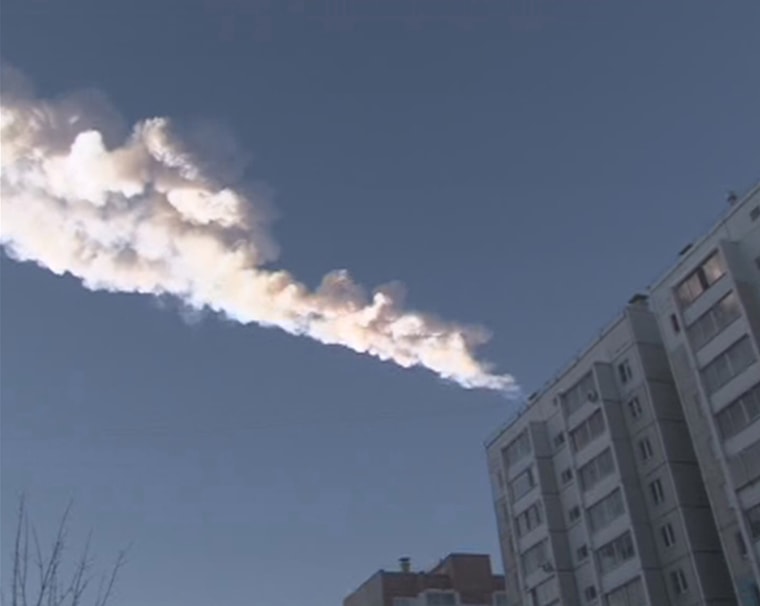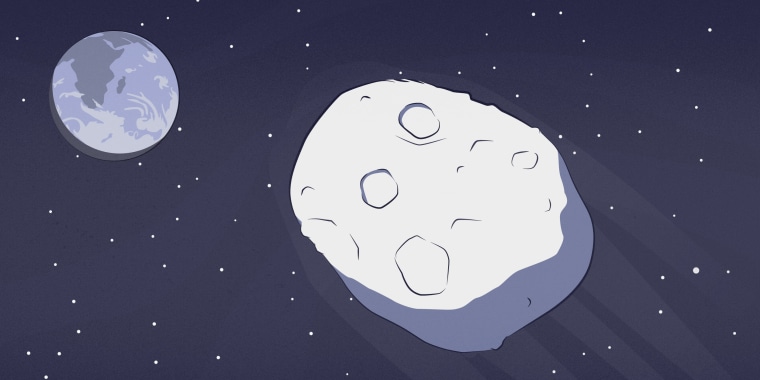An asteroid bigger than the Eiffel Tower hurtled past Earth early on Saturday at a speed of 10,400 miles per hour, missing us by 4.6 million miles — not quite a close shave, but not so far in astronomical terms.
Had the fast-moving space rock, dubbed 2006 QQ23, been following a different trajectory, it could have slammed into our planet with an explosive force of up to 500 times that of the atomic bomb dropped on Hiroshima, Japan.
But if 2006 QQ23 is no cause for alarm, it's a 1,150-foot reminder that somewhere in the cosmos another big and as-yet-unseen asteroid could be on a collision course with Earth.
"It’s 100 percent certain that we’re going to get hit, but we’re not 100 percent certain when," says Danica Remy, president of the B612 Foundation, a nonprofit organization in Mill Valley, California, that's working to protect the planet from asteroids.
Experts in so-called planetary defense are working on technologies to deflect large asteroids headed our way, but scientists say more needs to be done to detect them in time to take effective action.
Beyond planet-killers
Forget movies such as "Armageddon" and "Deep Impact."
Astronomers have been scanning the skies for years, and they've turned up no giant "planet killers" that we need to worry about. The chance that an object like the 7.5-mile-wide "impactor" that is believed to have hit Earth and wiped out the dinosaurs 65 million years ago is considered virtually nil.
NASA estimates that at least 95 percent of asteroids one kilometer (3,280 feet) or larger have been cataloged, with none posing a threat to Earth. The more realistic danger comes from space rocks the size of 2006 QQ23, which could flatten an entire city, killing millions and causing widespread destruction in the event of a direct hit.
"The kind of devastation that we’d be looking at is more of at a regional level than a planetary level, but it’s still going to have global impact — on transportation, networking, climate, weather," Remy says.
Just how devastating such a strike could be became unsettlingly apparent in May, when NASA, the Federal Emergency Management Agency and other agencies held a multiday simulation of an asteroid strike on New York City. The simulation showed that the impact of a 200-foot-wide object would kill 1.3 million people and destroy much of Manhattan.
The key to avoiding such a scenario is to go beyond the planet killers and find all the asteroids that could hit us. As Remy says, "The real issue is that we need to have an inventory of all the asteroids."
Kelly Fast, manager of NASA’s Near Earth Object Observation program at the agency's Washington, D.C., headquarters, agrees.
"The whole point is to be able to find all of these asteroids and to catalog their orbits precisely and to calculate them into the future," she says. "So, you know if it is going to pass 19 lunar distances away like 2006 QQ23 or if it is going to pass closer — or if it is going to pose an impact threat."
Trouble is, asteroids have been known to catch us off guard.
Unpleasant surprises
On July 25, an asteroid estimated at up to 450 feet across unexpectedly buzzed Earth at a distance of 40,000 miles, becoming the largest asteroid to come that close in a century. Yet we knew nothing of the space rock, dubbed 2019 OK, until astronomers in Brazil discovered it shortly before the flyby.
Perhaps the best-known example of an unexpected asteroid event came in 2013, when a 55-foot-wide asteroid hit the atmosphere over Chelyabinsk, Russia, falling toward the ground like a pop-fly that an outfielder lost in the sun. Though it mostly burned up in the atmosphere, the space rock caused a shockwave that shattered windows and injured more than 1,000 people.

"We weren’t aware of the Chelyabinsk asteroid" beforehand, says James Bauer, a University of Maryland astronomer affiliated with the International Asteroid Warning Network, which was established by the United Nations in the aftermath of the Chelyabinsk event. "It more or less came out from a geometry that was not viewable. It traveled on a solar approach that made it hard to detect."
Neutralizing the threat
In addition to detecting asteroids and simulating asteroid strikes, NASA is mounting a mission to test a system for deflecting an asteroid.
The agency's Double Asteroid Redirection Test (DART) mission, set to launch in 2021, will fire a so-called kinetic impactor into a binary asteroid known as Didymos. The idea is that the impact will alter the trajectory of the smaller of the paired asteroids, which are now on track to pass close to Earth in 2022.
"The impact will blow off material to give [the smaller asteroid] an extra push, just like if you’re standing on a skateboard and you threw a baseball one direction, you’d move in the other direction," Fast says, adding that an asteroid coming our way would need to be deflected by only a tiny amount to keep it from hitting Earth.
Another potential way to deflect an asteroid is to use a so-called gravity tractor — a spaceship sent not to strike an asteroid but to use its own gravity to shift the space rock's trajectory — a concept credited to former astronaut Ed Lu, founder of the B612 Foundation, and astronaut Stan Love. "The idea is you use the gravity between a small spacecraft and the asteroid to gently tug it into another orbit," Remy says.
Then there's the nuclear option: launching a nuclear warhead into space and detonating it near an oncoming asteroid. "It would not be like in the movies where they blow it up ... the blast would be near the asteroid and irradiate the surface," Fast says. "The blowoff from the surface is what would nudge the asteroid."
Of course, these approaches will work only if we have enough advance warning that an asteroid is headed our way. Experts say it would take years or perhaps decades to mount a mission capable of deflecting dangerous space rocks, and as Fast says, "the first order of business is to find them."
David Brin, a San Diego-based astrophysicist and science fiction author who serves as an adviser to the B612 Foundation, is confident that advanced technology will be able to protect the planet from a major asteroid strike like the one that did in the dinosaurs. "As far as asteroid strikes go," he says, "we need to remember that the dinosaurs aren’t here because they didn’t have a space program."
Want more stories about science?
- Deep inside Earth, scientists find weird blobs and mountains taller than Mount Everest
- Immense crater may have been found deep under Greenland's ice sheet
- This floating city concept is one way to cope with climate change
